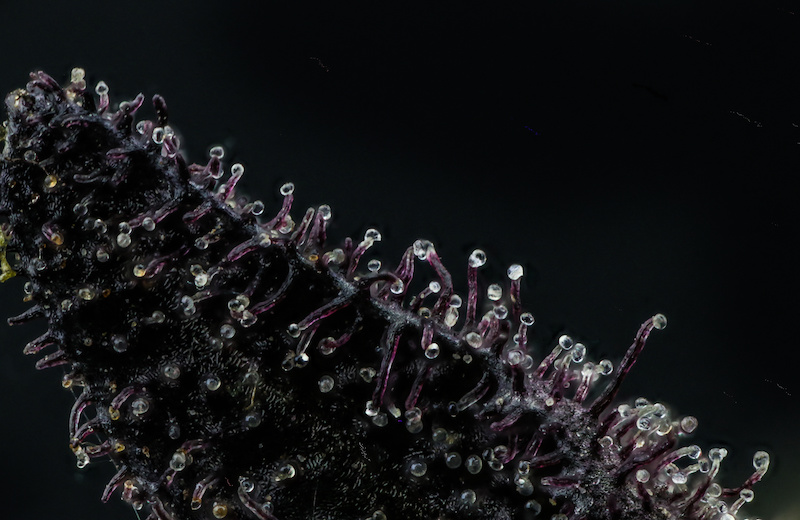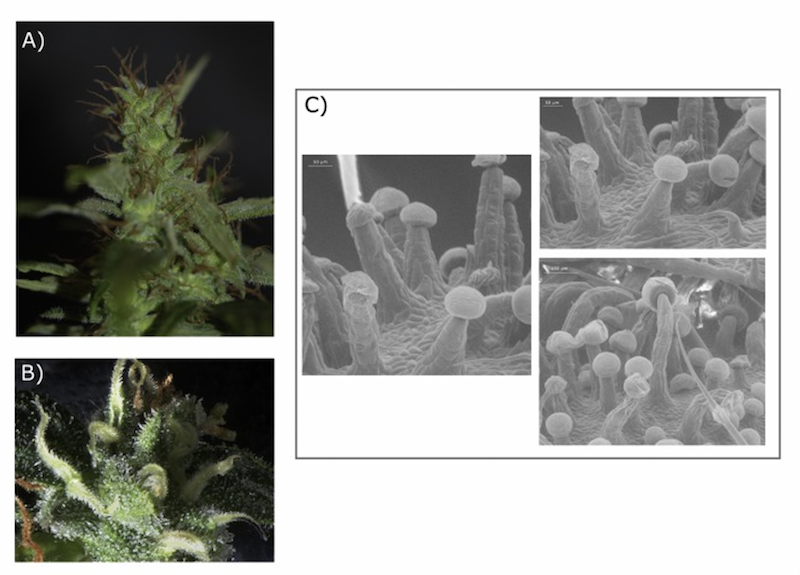Features
What makes cannabis smell like cheese, skunk, diesel
Published on July 7, 2023 by Special to the oz.
 Photo: Adobe stock/the oz.
Photo: Adobe stock/the oz. Ever wonder what makes cannabis smell in distinct ways? Terpenes and plant metabolites combine to bloom in your nose.
By Mariana Wolff | Special to the oz.
By now, most cannabis enthusiasts have become familiar with the names and roles of terpenes commonly found in cannabis.
For those who are still learning about these volatile aromatic molecules, terpenes are produced and stored in the sticky glandular trichomes that are quite visible to the naked eye on the surface of all matured cannabis buds.
Terpenes are responsible for the way certain cannabis plants smell and taste. These naturally produced metabolites also impact the perceived high and effects of the various cannabis varieties (“strains”) around today. Well-known terpenes that typically dominate the terpenoid profile of cannabis include; Pinene, Limonene, Caryophyllene, Myrcene and Linalool. These familiar terpenes give cannabis its pine, citrus, spice, earth and floral aromas.
• RELATED: How to read a cannabis label: common terpenes
There are, however, hundreds of different terpenes and terpene variations in any given cannabis variety, all of which contribute to the unique aromatic properties of this incredible plant.
What metabolites, then, are responsible for what makes cannabis smell like cheese, skunk or diesel smell? These distinct and coveted aromas are the product of a combination of certain terpenes with lesser known plant metabolites, volatile sulfur compounds (VSC).
What terpenes look like
 Photo: Contributed
Photo: Contributed What causes three coveted cannabis smells?
CHEESE
There is nothing like a well-cured UK Cheese bud that can be an acquired taste for cannaseurs. A certain volatile fatty acid (terpene), isovaleric acid (also known as isopentanoic acid), is responsible for the pungent sour cheese smell in various cannabis varieties. Isovaleric acid is also found in high quantities in a medicinally relevant plant root, valerian, which is famously stinky, reminiscent of cheesy feet. There are various volatile ester versions of isovaleric acid (metabolite cousins) that are less “ripe” smelling and tend to emit more pleasant aged cheese aromas. These are used commercially as food flavour and fragrance additives in the cosmetic and food industries, for example, powdered chicken flavour. Other plant sources of isovaleric acid include hops and tobacco.
SKUNK
There is no question a good strong skunk aroma is favourable and many use this as an indicator of good strong weed. This smell comes from the VSC mentioned before, rather than terpenes. These sulfur compounds are also found in great quantities in garlic and not surprisingly, skunk spray. An example of a VSC is 3-methyl-2-butene-1-thiol (a.k.a. prenylthiol). Prenythiol was recently identified as the primary odorant that is responsible for “skunkiness” in cannabis. Examples of varieties that are high in prenylthiol include Gelato and Apple Fritter strains. Since VSCs are soluble in hydrocarbon solvents, such as butane, it is no surprise that these metabolites are also present and responsible for skunk aroma in any full spectrum extracts, including resins. Interestingly, some of the health benefits of garlic, such as its anticarcinogenic properties, have been attributed to these VSCs, so it points to the importance of further investigating these metabolites in cannabis to identify any possible health benefit stemming from these VSCs.
DIESEL
Cannabis that smells like fuel is a bit more of a complex story and has yet to be fully elucidated. There are different classes of plant metabolites (certain terpenes and VSCs) likely playing a role here to create the popular and distinct gas or diesel aroma. However, this specific profile has yet to be investigated in scientific detail. We know certain cannabis varieties contain large and balanced quantities of Myrcene, Limonene and Caryophyllene, including OG Kush, Gelato, and Sour Diesel to name a few. We also know that some volatile organic sulfur compounds, such as sulfides and thiols, have a more fuel or diesel smell rather than a cheese smell. It stands to reason that the diesel aroma in cannabis may be coming from varieties that contain some signature combinations of yet unidentified VSCs and a balance of the cannabis dominant terpenes, Myrcene, Limonene and Caryophyllene
Appreciate cannabis’ whole cocktail of metabolites
It is interesting to note, that as THC potency increases in cannabis varieties from selective breeding due to consumer demand, the variety and quantities of other plant metabolites, such as terpenes and volatile sulfurs, decrease as the plant species is encouraged to focus on the production of a single metabolite, THC.
As cannabis consumers become more familiar with, and appreciative of, the whole cocktail of metabolites in cannabis, rather than a heavy focus on THC, the tremendous variety of this fascinating and versatile plant will continue to grow. Currently, because of lack of reference standard materials, poor resolution of certain metabolites (e.g., sesquiterpenes) and heavy cannabis regulation, there are still many undiscovered volatiles in cannabis today. As technology and method development improves over time, along with easier access to study this overregulated plant species, more yet undiscovered volatile plant metabolites will be found that will help further elucidate the distinct aromatic signatures of various cannabis varieties.
About the author
Mariana Wolff has a master’s degree in plant biochemistry from UBC and researched plant terpene biosynthesis as part of her thesis project. She owns a boutique shop in Penticton called Cannabis Cottage.
Read more about Mariana Wolff in her Q&A on the oz.
Article references
I.W.H. Oswald, M.A. Ojeda, R.J. Pobanz, K.A Koby, A.J. Buchanan, J.D. Rosso, M.A. Guzman, and T.J. Martin (2021). Identification of a new family of prenylated volatile sulfur compounds in Cannabis revealed by comprehensive two-dimensional gas chromatography, ACS Omega, 6(47), pp. 31667-31676
J.K. Booth, J. Bohlmann, Terpenes in Cannabis sativa – From plant genome to humans Plant Science, 284 (2019), pp. 67-72
J.K. Booth, J.E. Page, and J. Bohlmann (2017), Terpene synthases from Cannabis sativa, PLOS ONE, 12(3)
J.T. Fischedick (2017), Identification of terpenoid chemotypes among high (-)-trans-delta9-tetrahydrocannabinol-producing Cannabis sativa L. cultivars, Cannabis and Cannabinoid Research, 2(1), pp. 34-47
National Center for Biotechnology Information (2023). PubChem Compound Summary for CID 10430, Isovaleric acid. Retrieved June 19, 2023 from https://pubchem.ncbi.nlm.nih.gov/compound/Isovaleric-acid.
Leave a comment on our Facebook page.
© Copyright 2023 Okanagan Z. | About the oz.
Report a Typo or Inaccuracy
We strive to avoid typos and inaccuracies. However, on occasion we make mistakes. We value your contributions and help in correcting them.